Arterial Spin Labeling
Oral
Contrast Mechanisms
Monday, 18 June 2018
| W03/04 |
16:15 - 18:15 |
Moderators: Weiying Dai, David Thomas |
16:15
|
0302.
 |
 Advanced Automatic Planning for Super-Selective Arterial Spin Labeling Flow Territory Mapping Advanced Automatic Planning for Super-Selective Arterial Spin Labeling Flow Territory Mapping
Michael Helle, Fabian Wenzel, Kim van de Ven, Peter Boernert
This study presents an advanced fully automated approach based on vessel detection and analysis. It is completely integrated in the scanner console and allows labeling of the major brain feeding vessels in an efficient and robust way. Average processing time to find optimal labeling positions for all major brain feeding arteries is <15 seconds.
|
16:27
 |
0303.
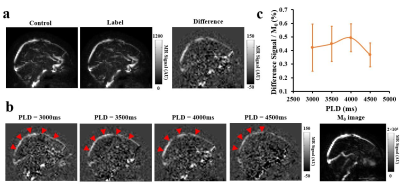 |
 Non-contrast assessment of blood-brain-barrier permeability with water-extraction-with-phase-contrast-arterial-spin-tagging (WEPCAST) MRI Non-contrast assessment of blood-brain-barrier permeability with water-extraction-with-phase-contrast-arterial-spin-tagging (WEPCAST) MRI
Zixuan Lin, Yang Li, Pan Su, Deng Mao, Zhiliang Wei, Jay Pillai, Abhay Moghekar, Matthias van Osch, Yulin Ge, Hanzhang Lu
A new method for non-contrast assessment of blood-brain-barrier (BBB) permeability to water has been proposed: water-extraction-with-phase-contrast-arterial-spin-tagging (WEPCAST) MRI, which allows selective imaging of venous ASL signal. Studies were performed to show proof-of-principle and Look-Locker readout were applied to expedite data acquisition. The results were consistent with previous literature. Mild hypercapnia was also shown to enhance the sensitivity of the technique significantly.
|
16:39
 |
0304.
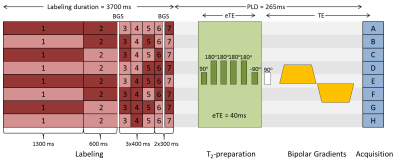 |
 Investigation into water transport mechanisms in the brain using a combination of T2 measurements and crusher gradients with ASL Investigation into water transport mechanisms in the brain using a combination of T2 measurements and crusher gradients with ASL
Leonie Petitclerc, Sophie Schmid, Wouter Teeuwisse, Matthias van Osch
TRUST and crusher gradients were combined with time-encoded pCASL to examine the transport of water from the vasculature to the tissue in the brain. At early time points, where the intravascular portion of the ASL signal is high, the crusher gradients resulted in a large reduction in the average signal. By comparing the intravascular fraction obtained from crushed signal to T2 measurements, it was observed that the change in T2 is greater in later time points than the change in intravascular fraction. This suggests that T2 methods are more sensitive to alterations in the blood-brain barrier than crusher gradient techniques.
|
16:51
|
0305.
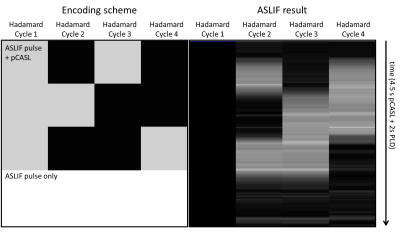 |
 Arterial Spin Labeled Input Function (ASLIF): signal acquisition during pseudo-continuous arterial spin labeling Arterial Spin Labeled Input Function (ASLIF): signal acquisition during pseudo-continuous arterial spin labeling
Matthias GŁnther
In ASL pseudo-continuous labeling (pCASL) is often used as a labelling scheme due to its increased SNR compared to pulsed variants. After labeling and a subsequent post-labeling delay, the amount of labeled blood in the organ of interest is acquired. In this abstract, we describe a new approach, which allows to measure the blood signal while it is labeled. Results are presented for a four-phase Hadamard-encoded pCASL sequence. This will ultimately allow for a realtime monitoring of the arterial input function in pCASL.
|
17:03
 |
0306.
 |
 Time-encoded golden angle radial ASL Time-encoded golden angle radial ASL
Merlijn van der Plas, Sophie Schmid, Maarten Versluis, Matthias van Osch
The golden angle readout provides a flexible approach to acquire multiple reconstructions, each with a different trade-off between spatial and temporal resolution from the same dataset. In combination with a Hadamard labeling scheme, the golden angle readout can be optimized for reconstructions at multiple spatial resolutions, allowing for multi-slice acquisition. By changing to single-slice acquisition, high temporal resolution angiography and high quality perfusion images can be reconstructed from a single dataset.
|
17:15
|
0307.
 |
 Cerebral Blood Volume Mapping using Fourier-Transform based Velocity-Selective Saturation Pulse Trains Cerebral Blood Volume Mapping using Fourier-Transform based Velocity-Selective Saturation Pulse Trains
Qin Qin, Yaoming Qu, Wenbo Li, Dapeng Liu, Taehoon Shin, Doris Lin, Peter van Zijl, Zhibo Wen
A new non-contrast cerebral blood volume (CBV) quantification technique is proposed using Fourier-transform based velocity-selective saturation (FT-VSS) pulse trains. Its utility is assessed for healthy subjects at 3T and compared to a method using conventional flow-dephasing VS pulse trains. FT-VSS showed greater immunity to gradient imperfections and up to 40% higher SNR. The better performance of FT-VSS pulse trains in CBV measurements can be explained by the effective background suppression related to its velocity-selective profile: static tissue signal in the saturation band and flowing spins in the passband, which is opposite from the velocity response of the conventional method.
|
17:27
|
0308.
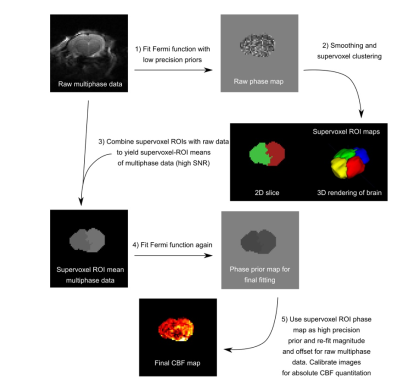 |
 Robust estimation of quantitative perfusion from multi-phase pseudo-continuous arterial spin labelling Robust estimation of quantitative perfusion from multi-phase pseudo-continuous arterial spin labelling
Michael Chappell, Martin Craig, James Larkin, Manon Simard, Nicola Sibson, Thomas Okell
Multi-phase pcASL has been proposed as a means to achieve accurate perfusion quantification that is robust to imperfect shim in the labelling plane. There exists a previously unrecognised bias in the estimation process that is a function of noise on the data. In this work this boas is addressed, exploiting information common to voxels containing tissue fed by the same artery, identified using clustering methods.
|
17:39
 |
0309.
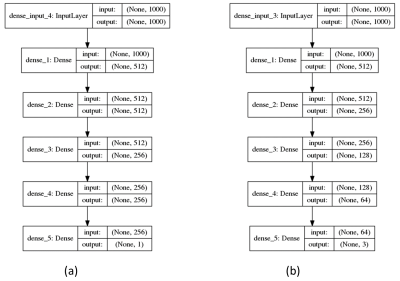 |
 Optimized Scan Design for ASL Fingerprinting and Multiparametric Estimation using Neural Network Regression Optimized Scan Design for ASL Fingerprinting and Multiparametric Estimation using Neural Network Regression
Anish Lahiri, Jeffrey Fessler, Luis Hernandez-Garcia
We investigate an optimization method for ASL fingerprinting acquisition schemes as well as a neural network framework for estimating hemodynamic parameters from the data.
|
17:51
|
0310.
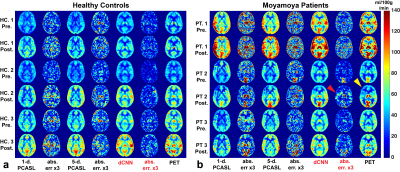 |
 Improving Perfusion Image Quality and Quantification Accuracy Using Multi-contrast MRI and Deep Convolutional Neural Networks Improving Perfusion Image Quality and Quantification Accuracy Using Multi-contrast MRI and Deep Convolutional Neural Networks
Jia Guo, Enhao Gong, Maged Goubran, Audrey Fan, Mohammad Khalighi, Greg Zaharchuk
We propose a novel method that uses deep convolutional neural networks (dCNNs) to combine multiple contrasts from MRI, including single- and multi-delay pseudo-continuous arterial spin labeling (PCASL) and structural scans, to synthesize perfusion maps that approach the accuracy of the PET perfusion measurements. The dCNN was trained and tested on both healthy and patient datasets, and demonstrated significant improvement on both image quality (higher structural similarity and lower normalized root mean square error) and quantification accuracy (regional CBF comparable with PET) than either ASL method alone. This method may potentially be generalized to other qualitative/quantitative applications.
|
18:03
 |
0311.
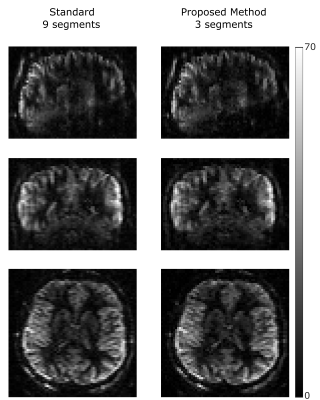 |
 Acceleration of arterial spin labeling data acquisition using spatio-temporal total generalized variation (TGV) reconstruction Acceleration of arterial spin labeling data acquisition using spatio-temporal total generalized variation (TGV) reconstruction
Stefan Spann, Christoph Aigner, Matthias Schloegl, Andreas Lesch, Kristian Bredies, Stefan Ropele, Daniela Pinter, Lukas Pirpamer, Rudolf Stollberger
3D imaging sequences such as GRASE or RARE-SoSP are the preferable choice for acquiring ASL images. However, a tradeoff between the number of segments and blurring in the images due to the T2 decay has to be chosen. In this study we propose a reconstruction algorithm based on total generalized variation for reducing the number of segments and therefore the acquisition time of one image. We incorporate the averaging procedure in the reconstruction process instead of reconstructing each image individually. This allows exploiting temporal redundancy and spatial similarity for improving the reconstruction quality of ASL images.
|
|












